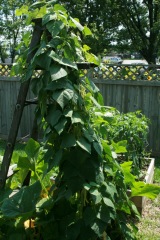The Garden In Review, 2009. What Went Right or Wrong
 Pole Beans 2009 was an ambitious year. We planted a lot of plants that we had never grown before. Some of our experiments turned out and some didn’t turn out so well.
Pole Beans 2009 was an ambitious year. We planted a lot of plants that we had never grown before. Some of our experiments turned out and some didn’t turn out so well.
One of the problems that faces new gardeners is fear. “But what if it doesn’t grow?”, “But I don’t know what it tastes like”, etc. Don’t get caught up in this trap. My advice is to take on several new techniques or plants per season. You are almost guaranteed to succeed with a large percentage of your endeavors. Sure, some will fail, but you almost always will learn something in the process.
I love unique vegetables. Belonging to the Seed Savers Exchange gives me the incredible resource of the “miscellaneous” section at the back of the yearbook. Truly fascinating plants and seeds are waiting to be found. I also love pushing the boundaries of our growing location. Just because someone tells me that I can’t grow something like bananas almost guarantees that I will try to prove them wrong. Gardening should be an adventure. Give into your inner child and just have fun.
OK, so what went wrong and what was a surprising success.
Tomatoes: Our garden usually is over half planted between just peppers and tomatoes. Last year, we planted over 30 varieties of tomatoes. I was especially excited because over 20 of them came from Belarus. It was the first time that I received seed from overseas. Unfortunately, my zeal got the better of me. I had grown so many tomatoes, that I started to forget some of the basics. Most important in this case was whether the tomato was determinate or indeterminate. In short, determinate tomatoes grow to a certain size and produce all of their fruit at the same time. Indeterminate tomatoes will grow continuously until killed back by frost. We have grown tomatoes over 20 feet tall without an special fertilizers or care. Failure: Getting to our problem. I pruned ALL of the tomatoes which greatly stunted the determinate tomatoes. Indeterminate tomatoes like being pruned to a single stem. Determinate tomatoes do not like this at all. Consequently, many of my tomatoes were a fraction of what they could have been if I had kept my dirty mitts off of them. Success: Favorite varieties that did quite well were Missouri Pink Love Apple, Pevenets Pomantsova, Aurantiacum and Violeceum Altaistky.
Peppers: My favorite! I had a great year with peppers produce fruit early while protected under my isolation sleeves which allowed me to save a lot of seed. A couple of standout plants were a Poblano and a Rocoto. I have tried for several years to grow Poblanos with any kind of size to them. Unfortunately, while my pepper plants produced nice yields of peppers that were quite small. Most ranged in the 2 – 3 inch long range. This past spring while driving back from the Carolinas, we stopped at a farmers market and I saw these Massive Poblanos. While any other reasonable person would have been salivating at the thought of eating them, I only was thinking of harvesting the seed and getting those babies in the ground. I did just that and had the best crop of Poblano peppers I have ever grown. Many averaged over 6 inches long and some were close to that wide. My second pepper, the Rocoto is another thing that they will tell you will not grow in our area, which is zone 5b. This year, I harvested almost 100 peppers from a single plant before frost. Because the peppers are so unique I strongly encourage you to try to grow this pepper. As a side note, peppers are perennials. Many growers plant rocotos in a container, bring them indoors in the fall and replant them the next season where they produce huge yields. Unfortunately for me, the plants are very large and my wife doesn’t really seem to like what look like half dead plants decorating the living room. Lastly, the one pepper I really didn’t care for was the Ghost Pepper or Bhut Jolokia. I really didn’t enjoy the taste and it is brutally hot attacking your breathing before singeing anything it touches.
Other standouts: Swiss Chard continues to grow though almost any conditions. If you are a fan of Spinach, you should give it a try. Swiss Chard gets much larger and has a stronger flavor but is fantastic if you pick the leaves while they are small. It is also beautiful in the garden, especially if you get any of the mixes that have different colors.
Lettuce in general is very easy to grow and just explodes in your mouth. If your only experience with lettuce is iceberg lettuce from the grocery store, then you absolutely have to grow a couple of varieties. Try different styles, such as head, Cos, loose leaf to see what matches your tastes.
Other Disappointments: Sea Berry never germinated for me. I planted quite a few seeds and just couldn’t get the plants to grow. Sea Berry is an ornamental shrub the produces small orange berries on the female plants. The berries can be picked and juiced for an orange juice substitute. In the end, I learned that this plant can be invasive and that the berries need quite a bit of sweetening to be palatable, so maybe this failure is a blessing.
I tried to grow Chia this year after reading about its health benefits. Unfortunately, I got this plant in the ground fairly late and it got much larger than I expected. It was almost 7 feet tall at frost. It was just forming its seed heads at frost. I will probably try again with an earlier planting this year.
Our Quinoa grew but only to about 2 feet tall and never produced any seed.
Red Milkweed and Dill. I planted both of these as butterfly food. But as Murphy’s Law raised its head, the Dill didn’t ever take off. I truly didn’t know this was possible. Every year, I have had dill growing in virtually every corner of the garden after planting it just one season. The Red Milkweed did grow but not very vigorously. The kids did bring a few Monarch caterpillars in to watch them form chrysalises, hatch and then be released. Dill is being planted again this year. I would like the kids to see Swallow Tail butterflies.
Amaranth has been a favorite ornamental for a few years. This year I planted a variety called “Hot Biscuits”. I was supposed to have bright orange seed heads. The plant itself was tan, the seed heads were more brown than orange and truly looked dead most of the season.
Jelly Melon! OK, truth be told this was not a failure. This plant dominated a 8 foot long bed from 4 little plants. Unfortunately, it is the nastiest, meanest plant, I have ever put in my garden. I couldn’t harvest anything out of that bed without leather gloves. The vines and leaves and COVERED with spines. Little tiny spines that immediately release from the plant and cause a great deal of discomfort. Yes, the fruit does indeed taste a little bit like a lime and banana, but the fruit has so many cell walls, that it really can only be squeezed rather than eaten directly.
Papalo, Cumin, Sunberry, and Orach were among my germination failures. No plants.
I continue to fail with melons which I find funny because they were the only thing I could grow when I first started gardening. I am sure I will continue to try, but I am not optimistic of my success.
Luckily, the winter provides the wonderful state of gardener amnesia. I am ready to do it all over again. Ready to try what failed and try some new ones. Have a great season.

































